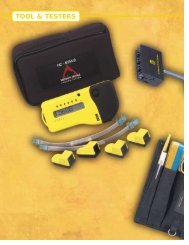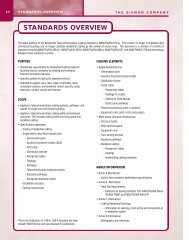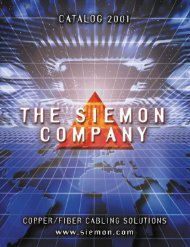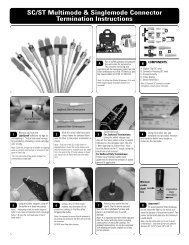fiber products
fiber products
fiber products
You also want an ePaper? Increase the reach of your titles
YUMPU automatically turns print PDFs into web optimized ePapers that Google loves.
Work Area<br />
Shielded<br />
Products<br />
Modular<br />
Patching<br />
Racks and<br />
Cable<br />
Management<br />
Patch Cords,<br />
Plugs and<br />
Cable<br />
S210<br />
Products<br />
S110<br />
Products<br />
Index<br />
Fiber<br />
Products<br />
HORIZONTAL DISTANCES OF COPPER LINKS (OPEN OFFICE)<br />
Copper work area cables connected to a MuTOA, shall meet the requirements of proposed ’568-B.1. The maximum length<br />
of copper work area cables shall be determined according to:<br />
C = (102 – H) / 1.2*<br />
W = C – 5 ≤ 22m(71 ft.)<br />
Where:<br />
C is the maximum combined length (m) of the work area cable,<br />
equipment cable, and patch cord (m).<br />
W is the maximum length (m) of the work area cable.<br />
H is the length (m) of the horizontal cable.<br />
The above equations assume that there is a total of 5m (16 ft.) of patch and equipment cables in the telecommunications<br />
room. Table 1 shows the application of these formulae. The length of work area cables shall not exceed 22m (71 ft.). The<br />
MuTOA shall be marked with the maximum allowable work area cable length.<br />
Length of Horizontal Cable<br />
Maximum Length of Work Area Cable<br />
Maximum Combined Length of Work Area<br />
Cables, Patch Cords, and Equpment Cable<br />
S66<br />
Products<br />
Protection<br />
H<br />
m (ft.)<br />
90 (295)<br />
85 (279)<br />
80 (262)<br />
75 (246)<br />
70 (230)<br />
Tools<br />
and<br />
Testers<br />
W<br />
*<br />
C *<br />
m (ft.)<br />
m (ft.)<br />
Standards<br />
Overview<br />
Application<br />
Guide<br />
Installation<br />
Practices<br />
Glossary<br />
5 (16)<br />
9 (30)<br />
13 (44)<br />
17 (57)<br />
22 (71)<br />
Table 1 — Maximum Length of Work Area Cables<br />
10 (33)<br />
14 (46)<br />
18 (59)<br />
22 (72)<br />
27 (89)<br />
Note: The preceding equation and table are based on patch cables having 20% more attenuation than horizontal cables. If higher gauge (e.g. 26 AWG) cables are used that have 50%<br />
higher attenuation than solid, as allowed by ISO/IEC 11801, these lengths must be reduced accordingly.<br />
HORIZONTAL DISTANCES OF OPTICAL FIBER LINKS (LONG WORK AREA CABLES)<br />
For optical <strong>fiber</strong> cables, any length combination of horizontal cables and work area cables is acceptable as long as the total<br />
combined length of the horizontal channel does not exceed 100m (328 ft.).<br />
When deploying a centralized <strong>fiber</strong> cabling topology, the general guidelines of proposed 568-B.1 shall be followed.<br />
Advantages and Features<br />
• It is preferable to use MuTOAs only when the<br />
entire length of the work area cord is<br />
accessible to facilitate tracing and to prevent<br />
erroneous disconnection. Up to 22 meters (71<br />
ft.) of work area cable are allowed.<br />
• MuTOAs are subject to the same interface<br />
requirements specified for each media type.<br />
• Consolidation point requirements are<br />
performance based. There is no physical<br />
interface requirement for the CP except those<br />
required to meet functional requirements.<br />
• Implementations using either MuTOAs or CPs<br />
are subject to the same end-to-end UTP/ScTP<br />
performance requirements.<br />
• Consolidation points have the advantage that<br />
they deliver dedicated TOs to individual work<br />
areas and do not require provisions for<br />
extended cord lengths.<br />
12•8<br />
T H E S I E M O N . C O M P A N Y








